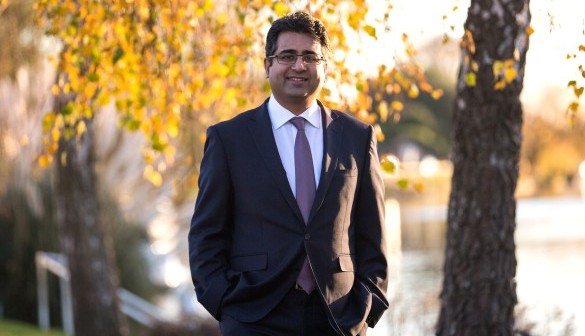India is in need of a cultural makeover and change of pace before it can become a global hub for innovation, writes India Inc. Founder & CEO Manoj Ladwa.
On my first visit to Palo Alto this week, I was impressed by its fabled innovation eco-system.
Palo Alto, arguably the main engine room of global innovation, is rich with an abundance and ubiquity of risk capital. All the leading tech venture capitalists (VCs) are present here and it is fairly easy to approach them with ideas for funding.
The other, more important end of the innovation spectrum – talent – is available in equally large measure in California, the state in which Palo Alto is located. Stanford University and the University of California, Berkeley, are only two of the most famous. There are several others. Palo Alto doesn’t depend only on local institutions for talent. It attracts the best brains from the rest of the US as well as from all over the world, including a large number from India. But what is most impressive in this beautiful corner of California is its “best in world” structured programmes of incubators and accelerators that quickly take concepts past the pilot stage to the market.
So, it begs the question: if so many Indians can meet with so much success in this far corner of the United States, where is the innovation eco-system in India? Despite some remarkable recent successes and the much-needed ballast provided by Prime Minister Modi’s Start-up India initiative, why is it still not at par with what I have seen on my short visit to Silicon Valley.
Can India adapt its current IT business model and evolve a reverse off-shore, on-shore model, where India works with global talent pools to bring cutting edge ideas to the market… but from India?
The answer is a complex one. Let me explain:
A huge factor contributing to the absence of an enabling eco-system is the risk-averse culture that exists in large parts of India. And the prime reason for this is that failure is often stigmatised in India.
Silicon Valley is full of successful entrepreneurs who hit pay dirt with their second, third and even later ventures. The failure of their earlier ventures – obviously bankable ones since many of them were backed by hardnosed venture capitalists – did not doom their futures and preclude them from access to fresh capital for their subsequent ideas.
Indian society still attaches a stigma to failure. This inculcates in most, but fortunately not all, people a fear of taking risks. Many youngsters are, therefore, conditioned from childhood not to try and break new ground and, instead, stick to the straight and the narrow path.
But risks and rewards are the twin bases on which Silicon Valley has built its edifice of success – nurturing innovative ideas and backing enterprising individuals even if one or more past ventures haven’t paid off.
I read a story in ‘The Economic Times’ only a few days ago about an Indian pilot who has built a six-seater plane in his backyard in Mumbai. He has been unable to get permission from the Director General of Civil Aviation (DGCA), regulator of all civilian planes in India, to fly his aircraft and prove that his idea is worth pursuing further. After trying for six years – even the Prime Minister’s Office has been unable to get the DGCA to change its mind – the innovator now plans to take his drawings to the US to try and prove his plane airworthy.
If he succeeds, it will be a lost opportunity for India.
But I remain optimistic about the future. Placement statistics from the IITs and the IIMs, India’s premier engineering and management institutes, show that over the last few years more and more young graduates are giving up the lure of fancy salaries and chasing their entrepreneurial dreams by starting up new innovative ventures.
This is showing up in the headline numbers as well. According to a report by Nasscom-Zinnov titled ‘Indian Start-up Ecosystem Maturing – 2016’, India retained its position as the world’s third largest start-up hub in 2016, slightly behind second-placed UK. The top position was expectedly occupied by the US.
Last year, as many as 1,400 start-ups opened shop and received over $4 billion in funding. The Indian start-up scene is expected to grow 2.2x from the 2016 figure to more than 10,500 by 2020. The report for the current year is expected shortly.
The Prime Minister’s Start-up India programme, which hand-holds entrepreneurs from concept to cash flow, has come as a massive boost to India’s innovation eco-system. It is fostering an environment akin to that existing in Silicon Valley, by ushering in a culture where experienced businessmen willingly lend a helping hand, in addition to funds and management expertise to bring innovative ideas to the market.
The government’s initiative to host the Eighth Global Entrepreneurship Summit 2017 in Hyderabad from November 28-30 – the first time it will be held in South Asia – will also help Indian start-up entrepreneurs network and build partnerships with, pitch ideas to and secure funding from the world’s leading tech entrepreneurs and venture capitalists.
The Summit, which will be addressed by Prime Minister Modi and the US President’s daughter, Ivanka Trump, will have a theme of “Women First – Prosperity for All” and primarily focus on four areas – healthcare and life sciences, digital economy and financial technology, energy and infrastructure and media and entertainment.
Palo Alto has several other attributes that I think India can emulate. It has great role models and mentors, an atmosphere of intellectual honesty and an almost total absence of class hierarchy. Some people may find it brash but at least no one wastes time in getting to the point. Result: What you see is what you get.
Which brings us back to my question: Can India – with 2.4 million Indian expats in the US and another 1.5 million in the UK, many of them holding senior positions in the tech industry as well as in government – establish a global network, similar to Palo Alto, to bring talent to its own shores?
In IT, Indian companies, working in India and at client locations abroad served the software needs of its customers in their home markets. What I am proposing is the opposite – where innovators and companies in, say, the US, the UK, Israel and elsewhere work in close conjunction with principals in India to design innovative products and services for Indian companies.
There are some greenshoots already visible and the Start-up India initiative promises to speed up the process. India has a cost arbitrage while Palo Alto has an established innovation-at-scale arbitrage.
Google’s India-born CEO Sundar Pichai told the ‘Guardian’ in a recent interview that he believes that some great tech innovations are already taking place in India. For example, Google’s recent tap-to translate and Tez payment app were developed in and for India, with some support from Google’s global operations.
But, he added, the fundamental difference is the pace of development at Palo Alto and India.
That is what is needed in India – a change in pace, a cultural makeover that does not stigmatise failure and out of the box thinking. Add this to the bucket loads of talent and tech education that India brings to the table and you’ll have the eco-system that is needed to foster innovation.







